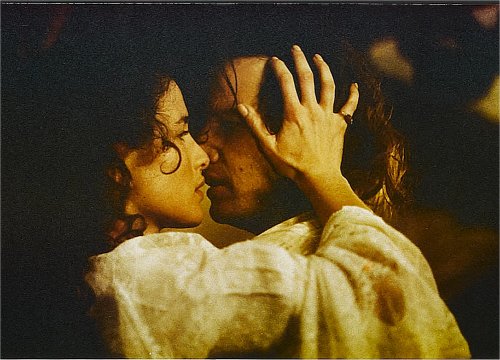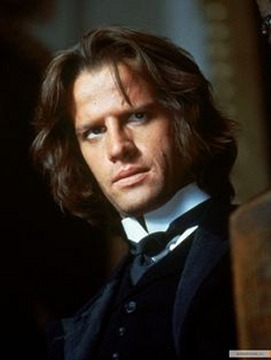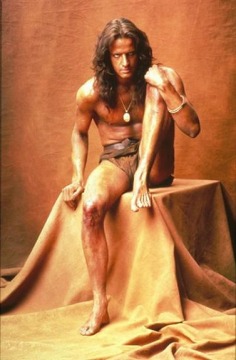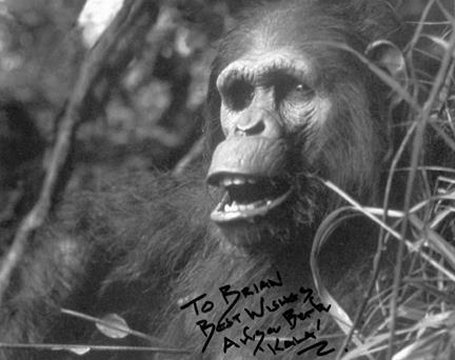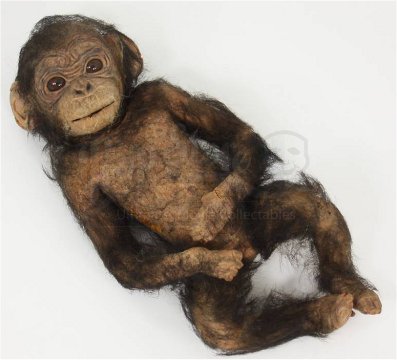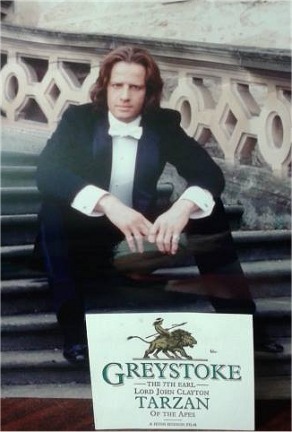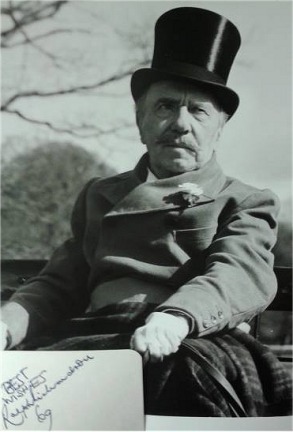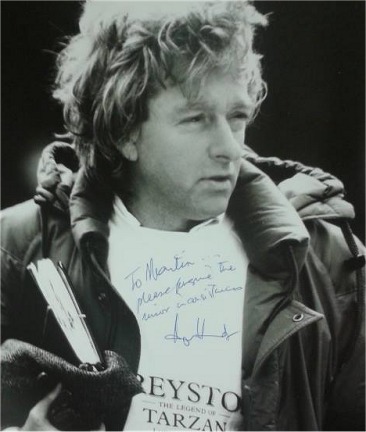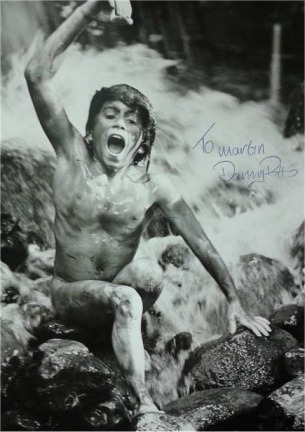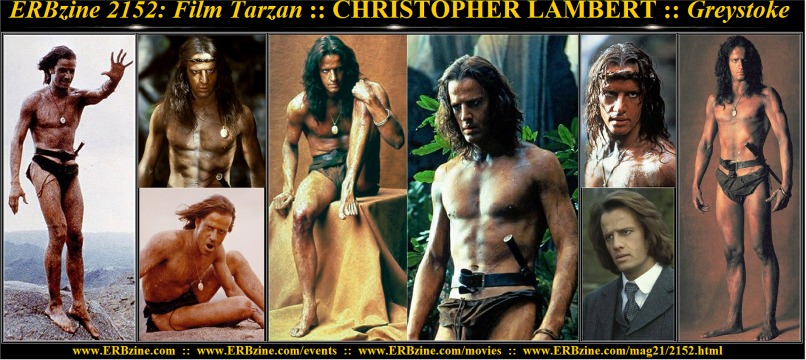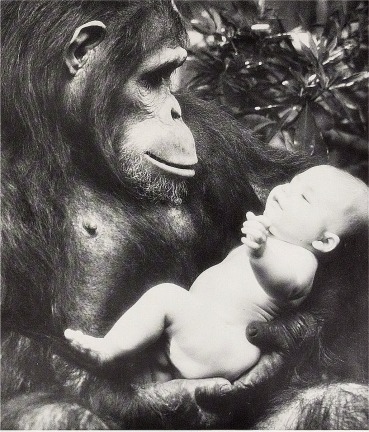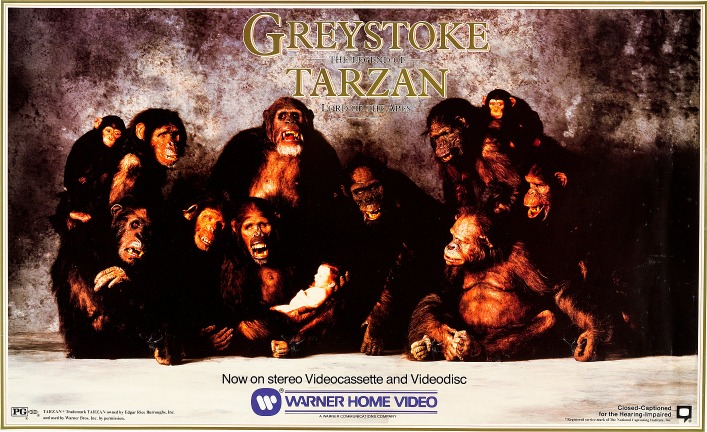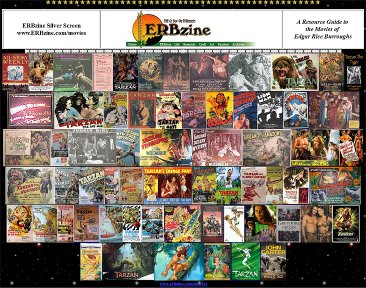
HOLLYWOOD AND VINE:
THE MOVIES OF TARZAN
http://www.inthebalcony.com/page31.html
by Philip Schweier

Tarzan began as a 95,000-word story by novice author Edgar
Rice Burroughs, a struggling businessman with a long string of failures
behind him. In an effort to escape an unsatisfying reality, the 37-year
old turned to the fantastic fiction pulps of the day for distraction. Believing
he could write better, he sold his first story, A Princess of Mars, for
$400.
His second story, TARZAN OF THE APES, was published for
$700 in the October 1912 issue of All Story Magazine. It was an instant
hit, and a sequel quickly followed. The adventure stories featured action
and intrigue from the jungles of Africa to Paris, then back to the Sahara.
Subsequent books were overflowing with thrills from wild animals, hostile
desert tribesman, foreign spies, lost cities and prehistoric creatures.
Fortunately, Burroughs had the foresight to retain the
rights to his creation, leading to a multimillion dollar empire built on
his literary properties. Before his death in 1950, the author would write
a total of 95 books, 24 of them Tarzan novels, and see his creation translated
into dozens of languages, as well as comics and motion pictures.
The very first Tarzan film in 1918 was entitled TARZAN
THE APE MAN, and starred Elmo Lincoln. He would go on to portray the Ape
Man in two sequels, primarily very broad adaptations of the novels. Over
the next 10 years, Tarzan was played by a handful of actors in a total
of nine silent films, the most notable being James Pierce in 1927's TARZAN
& THE GOLDEN LION.
Pierce would go on to marry Burroughs' daughter Joan.
Together, they would star as Tarzan and Jane in 365 15-minute radio dramas.
Produced by ERB, Inc. in 1931, they were pre-recorded and syndicated to
radio stations throughout the U.S. and Canada. This introduced the concept
of pre-record programs, rather than the live shows common at the time.
In the meantime, Burroughs continued to license his character
to any filmmaker interested. One of those was Sol Lesser, who had come
by the Tarzan rights secondhand, though they were technically expired.
A legal loophole granted him permission to make his own Tarzan movie. With
the advent of talking pictures, he hoped to start fresh, distancing himself
from any films that had come before.
However, a clause in Jim Pierce’s contract obligated an
offer, so Lesser had to convince the son-in-law of the ape man’s creator
to pass on any future Tarzan roles. Toward that end, he offered Pierce
$5,000 and an MGM screen test in exchange for stepping aside. Pierce accepted
the deal, and in his screen test was given a Shakespearean soliloquy. Hardly
a level playing field for a former football star trying to build a film
career!
Meanwhile, MGM was on the verge of launching the career
of one of the most famous screen Tarzans. Johnny Weissmuller had won five
Olympic gold medals in 1924 and ‘28 for swimming. His lean, muscular physique
suited him for MGM’s first remake of TARZAN THE APE MAN in 1932. For the
first time, audiences were treated to what would become Tarzan’s signature
ape call. Though often imitated, it has never been duplicated, as it is
a blend of various sounds, including an Austrian yodel provided by Weissmuller
himself.
Contrary to popular belief, at no time in the film does
Weissmuller ever say “Me Tarzan. You Jane.” Co-starring was a young Irish
actress, 20-year old Maureen O’Sullivan, whose skimpy costumes were rather
racy at the time, and helped lead to the creation of the Hayes Commission
to oversee decency in movies.
In 1933, Lesser cast Buster Crabbe, also a former Olympic
swimmer, as Tarzan. Though initially rejected for the lead in MGM’s Tarzan,
he had starred as Kaspa the Lion Man in Paramount’s King of the Jungle.
TARZAN THE FEARLESS was released both as a feature and a serial. The independent
production was widely panned, especially in comparison to MGM’s Tarzan
version.
In 1935, Burroughs was invited to become a partner in
a small film company, and was promised a greater degree of creative control
over his heroic creation. This time, instead of a semi-literate ape man,
the jungle lord was more faithful to his literary roots. Tarzan was an
intelligent, educated English lord raised in Africa, and spent his free
time roaming the jungle, often discovering lost civilizations.
Herman Brix, another 1928 Olympic athlete, was cast in
the lead role. He also had been considered for the role when MGM was casting
their version in 1932, but director W.S. Van Dyke passed him over because
Brix was still recovering from a broken shoulder received while filming
his first movie, TOUCHDOWN.
THE NEW ADVENTURES OF TARZAN was released in 1935 in a
12-chapter serial format. Filmed on location in the rainforests of Guatemala,
to describe it as uneven is being overly generous. Brix tried to disassociate
himself from a lackluster career beginning. Changing his name to Bruce
Bennett, he began developing his acting skills, eventually becoming a contract
player at Warner Brothers, with roles in such films as DARK PASSAGE and
TREASURE OF THE SIERRA MADRE.
Meanwhile, Lesser was moving ahead on his next picture.
With Crabbe now starring in the successful Flash Gordon serials, TARZAN’S
REVENGE (1937) starred Glenn Morris, another Olympian. The following year,
TARZAN AND THE GREEN GODDESS, a re-edited feature version of NEW ADVENTURES,
was released in an effort to recoup some of its losses.
By now the jungle had become somewhat crowded, and MGM’s
series overshadowed all others. Weissmuller, as Tarzan, had adopted a jungle
foundling in his fourth film with O’Sullivan TARZAN FINDS A SON (1939).
Boy, as he was named in the film, was played by Johnny Sheffield. It was
originally planned to kill Jane off at the end of the film, but the studio
reconsidered at the last minute. Two more films followed before O’Sullivan
decided to leave the jungle following 1942’s TARZAN'S NEW YORK ADVENTURE.
Their Jane gone, it was an easy decision for MGM to drop
Tarzan, as the war in Europe had eliminated their foreign market, and wartime
rationing forced production cutbacks. Lesser managed to buy Weissmuller’s
contract from MGM and take the series to RKO. Jane was written out, but
Sheffield, as Tarzan’s adopted son, accompanied Weissmuller to their new
studio home.
RKO turned out six more films, beginning with TARZAN TRIUMPHS
in 1943. At the time, isolationism was a dangerous foreign policy. Allegedly,
the U.S. State Department, feeling Tarzan to be a vital propaganda weapon,
asked that a wartime story be filmed. In the movie, Nazi aggression spreads
to Africa, but Tarzan isn’t concerned, believing the fighting in Europe
to be too far away. But when Boy is taken hostage by a German army expedition,
an angry Tarzan growls, “Now Tarzan make war!”
In 1945’s TARZAN AND THE AMAZONS Jane returned, played
by Brenda Joyce. Four movies later, following TARZAN AND THE HUNTRESS (1947)
it was obvious Boy was on the verge of becoming a man, and Sheffield left
to take on the role of Bomba the Jungle Boy in Monogram’s 12-film series
before hanging up his loin cloth for good in 1955.
Weissmuller’s long reign came to an end with 1948’s TARZAN
AND THE MERMAIDS. However, his jungle career would continue. Under producer
Sam Katzman, Weissmuller starred as Jungle Jim in 20 films between 1948
and 1956. Based on Alex Raymond’s comic strip, the series was essentially
Tarzan in khakis.
Assuming the mantle of the ape man in 1949’s TARZAN'S
MAGIC FOUNTAIN was Lex Barker, who followed the jungle trail laid down
by his predecessor, complete with an adopted son. Brenda Joyce returned
as Jane, but a painful divorce and unsatisfying career drove her out of
Hollywood after their first film together. Barker played the role for 5
films, until 1953’s TARZAN AND THE SHE-DEVIL.
With the release of TARZAN'S HIDDEN JUNGLE (1955), several
changes were made to the film series. Most obvious was a new actor, former
drill instructor and life guard Gordon Scott. However, it would prove to
be the final film released through RKO due to the studio's financial difficulties.
The studio was later sold to Lucille Ball and Desi Arnaz, who renamed it
DesiLu.
Lesser offered MGM a distribution deal, returning the
series to its former home. This allowed for new life to be breathed into
the franchise, beginning with 1957's TARZAN AND THE LOST SAFARI. For the
first time, the ape man was presented in color, and he began to speak like
an educated human.
Up until this time, most films were shot on the studio
backlot, though a few had gone to the swamps of Louisiana or Florida for
a greater degree of authenticity. While some of the Lex Barker films boasted
being the first to be shot in Africa, such footage was usually background
shots and the like. LOST SAFARI was the first to send the cast and crew
to British East Africa.
As successful as LOST SAFARI may have been, its follow-up,
TARZAN'S FIGHT FOR LIFE (1958) was a disappointment. Suspecting that the
jungle lord may have worn out his welcome on the big screen, Lesser set
his sights a bit lower, but efforts to bring the ape man to TV were stillborn.
A second radio program had been running, and its producers held the television
rights. The three pilots that were intended to launch the series were then
cobbled together to form TARZAN AND THE TRAPPERS (1958).
Following his failed attempts at a Tarzan TV series, Lesser
had grown weary and his health had begun to suffer. Under the belief that
Tarzan had exhausted the market, he sold out to Sy Weintraub's Banner Productions.
With fresh blood at the helm, TARZAN'S GREATEST ADVENTURE in 1959 was very
well received. Perhaps its success coupled with Weintraub's inexperience
with MGM contributed to the studio's efforts to hijack the series.
A common clause in MGM's contracts granted them the right
to re-make any film originally produced by the studio. This included TARZAN
THE APE MAN, even though the Burroughs estate had placed the character
rights in Weintraub's hands. MGM moved forward with their movie, but the
costly legal battle that ensued prompted the studio to cut the film's budget
wherever possible. Starring the unknown and barely remembered Denny Miller,
the remake is a mish-mash of stock footage, mostly from KING SOLOMON'S
MINES (1950) and tinted footage from the 1932 version starring Johnny Weissmuller.
Meanwhile, Scott would return to the role for a sixth
and final time in 1960's TARZAN THE MAGNIFICENT. His nemesis in the film
was played by Jock Mahoney, who would star in TARZAN GOES TO INDIA (1962).
Feeling Africa had become too modern, scriptwriters borrowed a page from
the fledgling James Bond series, hoping exotic locations would help keep
the series fresh. TARZAN'S THREE CHALLENGES (1963), also starring Mahoney,
took the ape man to the jungles of Thailand. Mahoney left the role, though
he would return as the villainous Colonel in the TV series, and as stunt
coordinator for the 1982 remake of TARZAN THE APE MAN.
Continuing the “out of Africa” trend, Mike Henry's first
outing, TARZAN AND THE VALLEY OF GOLD (1966) was set in Mexico. Though
he would leave the role six months before his first film was ever released,
Henry, a former football star, has been praised as one of the best screen
Tarzans, closely resembling the comic book Tarzan published by Gold Key
at the time.
What a monkey bite looks likeTwo more pictures were rushed
into production, but heavy rains on location in Brazil delayed filming,
and the floods that followed destroyed sets, causing further setbacks and
extending the company’s time spent out of the States. The interminable
shoot in South America left Henry homesick and miserable. After being bitten
by Dinky the chimpanzee, he suffered a bout of “monkey fever” for two weeks.
Exhausted, the chronic injuries and illness on the set
prompted him to return to California. There he chose to abandon the role
and file two separate lawsuits against Banner Productions claiming “abuse
and working conditions detrimental” to his safety and well-being.
Meanwhile, in 1966, producer Sy Weintraub's plans for
a Tarzan TV series were realized in the form of Ron Ely, who would become
identified with the role much as Johnny Weissmuller had. But like Henry
before him, he also suffered numerous injuries while filming, 17 of them
before the first episode aired. Manuel Padilla Jr., who had roles in two
of Henry's films, co-starred as Jai, Tarzan's Boy-ish ward.
VALLEY OF GOLD was released in 1966, followed by TARZAN
AND THE GREAT RIVER in 1967, and TARZAN AND THE JUNGLE BOY in 1968. That
same year, after 57 episodes, the television series ended, but a couple
of two-part episodes were re-edited as feature films in 1970. By this time,
Tarzan had run out of steam, and Hollywood’s longest-running film franchise
came to a halt.
In 1976, Tarzan returned to the small screen in the form
of a Saturday morning program from Filmation. Featuring rather lifelike
animation, 36 episodes of TARZAN, LORD OF THE JUNGLE were produced, airing
until 1979. Though Bob Ridgley lent his voice to the jungle lord, the famous
ape call was provided by Danton Burroughs, the author’s grandson.
About this time. Robert Towne, who won an Academy Award®
for writing CHINATOWN (1974), signed with Warner Brothers. One of his ambitions
was to make the definitive Tarzan movie. In a letter from to Marion Burroughs
in 1977, Warner Brothers Vice Chairman describes Towne’s efforts as, “a
superb screenplay... the basis for a film of which we all will be immensely
proud.”
Meanwhile, MGM once again exercised its option to remake
TARZAN THE APE MAN. Shot over eight weeks in Sri Lanka, the film was released
in 1982, and was little more than a vehicle for Bo Derek. Directed by her
husband John, the story is told from Jane’s perspective. Although Bo is
a remarkable beauty, it is to her benefit that Miles O’Keefe as Tarzan
had no lines, otherwise his acting might have upstaged hers.
While her performance may not have attracted much attention,
her nude scenes did, and the movie received an R rating, much to the dismay
of the Burroughs estate. However, the $6 million movie grossed over $36
million, making it the most financially successful Tarzan movie at the
time.
Robert Towne left Warner Brothers over a dispute while
writing and directing PERSONAL BEST (1981). His script ended up in
the hands of Hugh Hudson, who had won an Oscar in 1982 for CHARIOTS OF
FIRE. Hudson felt the script to be unfinished, and a second screenwriter
introduced a great deal of romantic Victorian atmosphere in an effort to
polish it. Though its screenplay would be nominated for an Oscar, Towne
removed his name from the film, and is credited as P.H. Vazak, a name he
borrowed from his dog.
GREYSTOKE: THE LEGEND OF TARZAN, LORD OF THE APES (1984)
is a beautiful piece of filmmaking, but the movie still deviates from the
jungle action from which the character was born. Tarzan, played by Christopher
Lambert, is discovered in the wilds of Africa by D’Arnot (Ian Holm). He
is then taken to England where he meets his grandfather, The Earl of Greystoke,
played by Sir Ralph Richardson in his final role. It is here that Tarzan
also encounters Jane Porter, portrayed by Andie McDowell (but dubbed by
Glenn Close post-production, much to Miss McDowall's embarrassment).
Tarzan continued to be a viable property, though many
subsequent interpretations leave a great deal to be desired. Joe Lara starred
in modern day tale entitled TARZAN IN MANHATTAN (1989). With Jane a cab
driver and her a father a private detective (played by an aging Tony Curtis,
who should have known better), the less said about the movie the better.
After a more successful syndicated series starring Wolf Larson ran from
1991-1994, Lara returned to the role. TARZAN: THE EPIC ADVENTURES lasted
26 episodes in 1996. The series borrowed heavily from much of Burroughs’
original works, but low budgets kept the series from ever taking full advantage
of the author’s broad imagination.
In 1999, TARZAN AND THE LOST CITY starring Caspar Van
Dien was released. It may be more in tone with the original books, with
a little bit of Indiana Jones thrown in. Nevertheless, the low budget (a
mere $20 million) prevents it from being an altogether satisfying interpretation.
Some of the violence of the film was toned down to make it more family
friendly.
However, Disney had been working on a spectacular big
screen adaptation that was a blend of groundbreaking animation, innovative
film technique, and the successful formula of music and talking animals.
To say Tarzan was perfectly suited for it is an understatement. Pop star
Phil Collins, the former drummer for the band Genesis, provided songs heavy
on jungle drums. Tony Goldwyn and Minnie Driver lent their voices as Tarzan
and Jane. The highly successful 1999 film (simply called TARZAN) spawned
a half-hour syndicated TV series, this time starring Michael T. Weiss and
Olivia d'Abo. They would reprise their roles for the direct-to-video sequel,
2002's TARZAN AND JANE. In 2006, a stage version of the film debuted on
Broadway.
In 2003, The WB had a hit series in the form of the Superman-based
SMALLVILLE. In an effort to duplicate that success, the network aired a
21st century version of Tarzan, in which his uncle, a corporate mogul,
has transplanted the young heir to Greystoke Industries from the jungle
in which he was found to New York. There, he attempts to civilize Tarzan
despite the budding romance between the ape man and NYPD detective Jane
Porter. Starring model Travis Fimmel, it was cancelled after only eight
episodes.
To learn about Tarzan’s appearances in comics, visit:
comicbookbin.com/bubble070.html.
Philip Schweier is a lifetime fan of old movies, comic
books, and cheap thrills in general, all in color for a dime. A graphic
designer by day, this mild-mannered newspaperman has taken to writing at
the suggestion of his wife, who has become increasingly bored with his
lectures about film, TV and comics. Send praise and adulation or scorn
and ridicule to him at pschweier@hotmail.com.

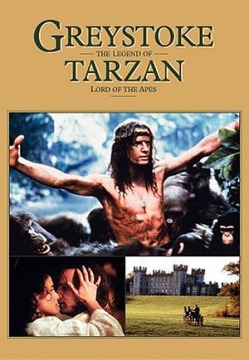
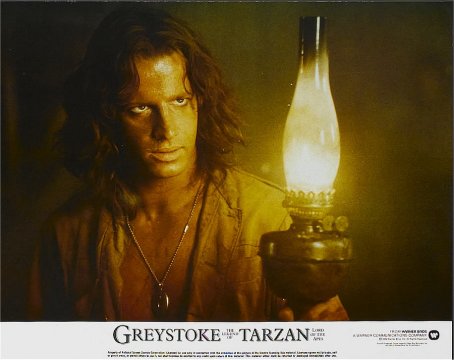
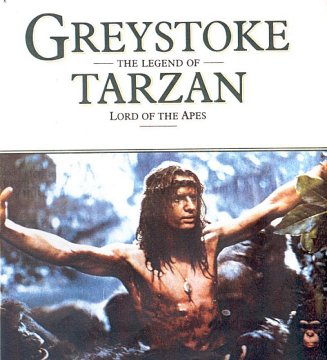
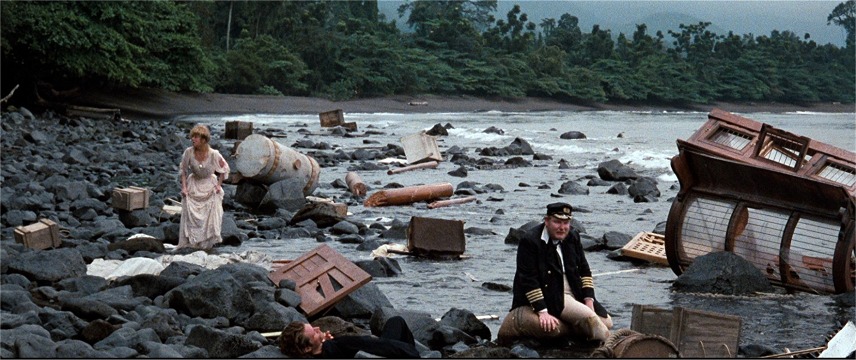
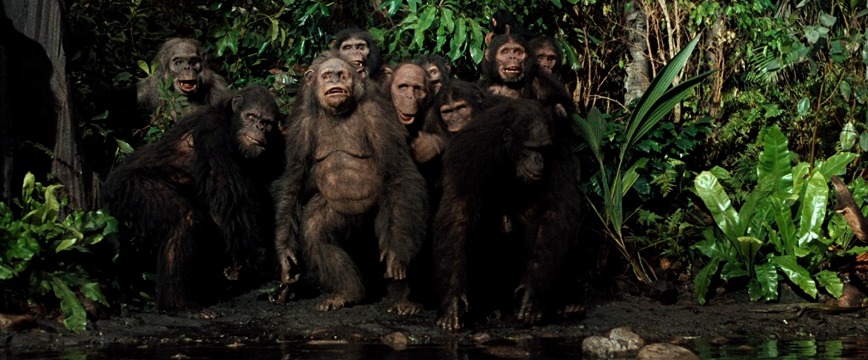
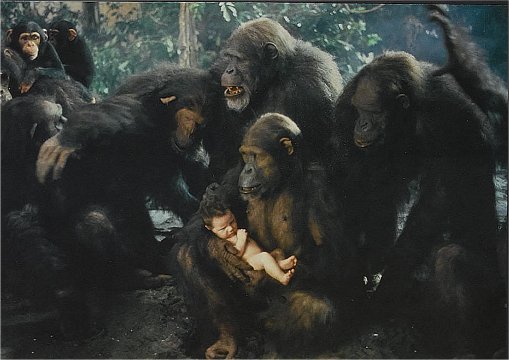 .
.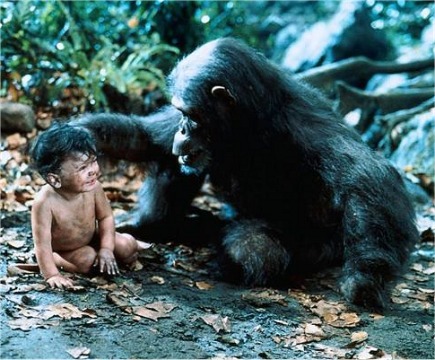
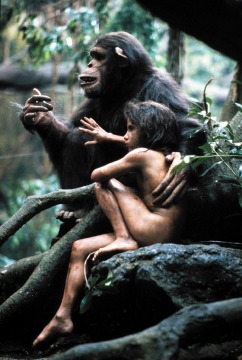 .
.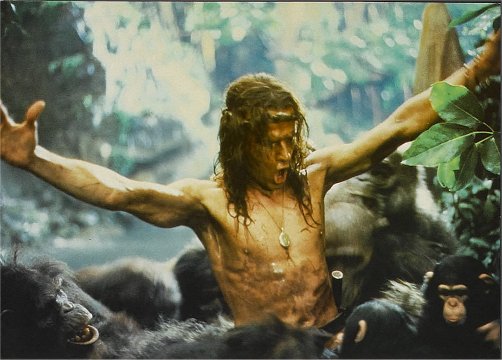
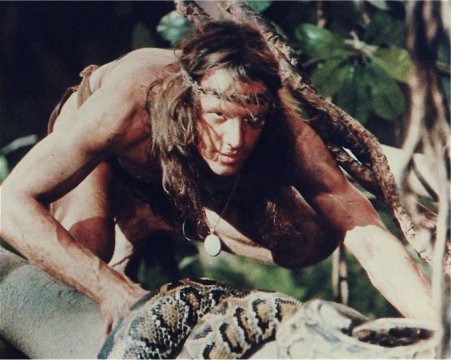 .
.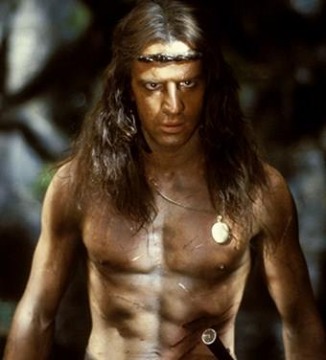
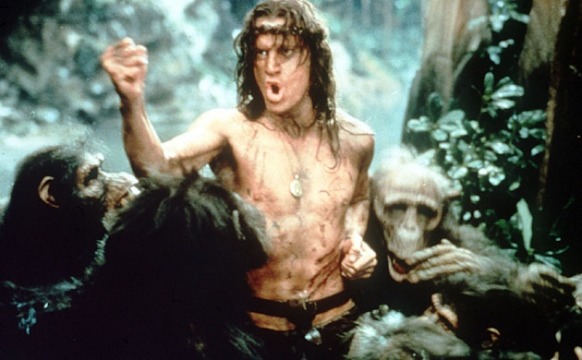 .
.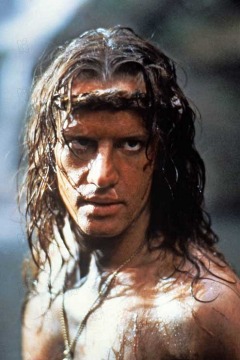
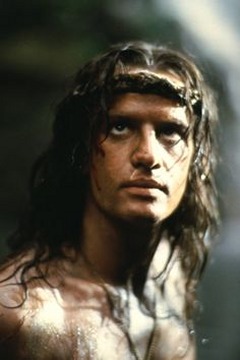 .
.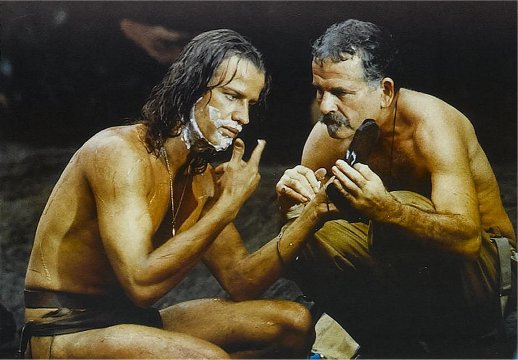
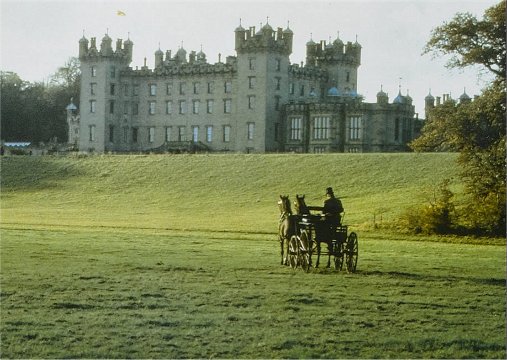 .
.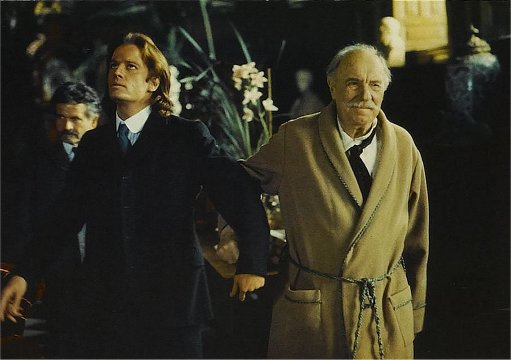
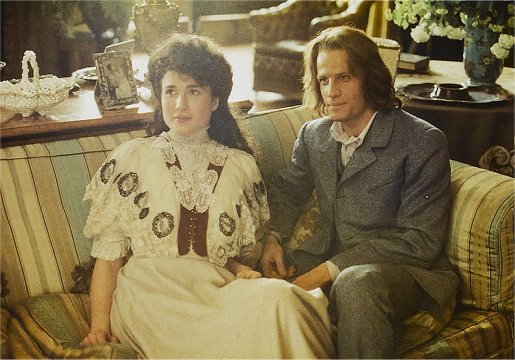 .
.